Readings Newsletter
Become a Readings Member to make your shopping experience even easier.
Sign in or sign up for free!
You’re not far away from qualifying for FREE standard shipping within Australia
You’ve qualified for FREE standard shipping within Australia
The cart is loading…






For courses in introductory calculus-based physics.
Physics for Scientists and Engineers: A Strategic Approach with Modern Physics incorporates Physics Education Research and cognitive science best practices that encourage conceptual development, problem-solving skill acquisition, and visualisation. Knight stresses qualitative reasoning through physics principles before formalising physics mathematically, developing student problem-solving skills with a systematic, scaffolded approach. The text presents a finely tuned, practical introduction to physics with problems that relate physics to everyday life and includes models, modeling, and advanced topics.
Samples Download the detailed table of contents
Preview sample pages from Physics for Scientists and Engineers: A Strategic Approach with Modern Physics
Features
Model boxes enhance the text’s emphasis on modeling - analysing a complex, real-world situation in terms of simple but reasonable idealisations that can be applied over and over in solving problems. These fundamental simplifications are developed in the text and then deployed more explicitly in the worked examples, helping students to recognise when and how to use recurring models (such as motion with constant acceleration or the photon model of light).
Looking Back Pointers enable students to look back at a previous chapter when it’s important to review concepts. Pointers provide the specific section to consult at the exact point in the text where they need to use this material.
Visual chapter summaries consolidate understanding by providing each concept in words, math, and figures and organising these into a vertical hierarchy - from General Principles (top) to Applications (bottom). Advanced topics as optional sections further expands instructors’ options. Topics include rocket propulsion, gyroscopes and precession, the wave equation (including for electromagnetic waves), the speed of sound in gases, and more details on the interference of light. Tactics Boxes give step-by-step procedures for developing specific skills (drawing free-body diagrams, using ray tracing, etc.).
New to this edition
4-step problem-solving approach shifts to Model/Visualise/Solve/Review, using a final step of ‘Review’ rather than ‘Assess’ to better reflect the content of the final step. This approach provides a framework throughout the book, using the 4-step framework with detailed problem-solving strategies for different topics and types of problems. Tactics Boxes give step-by-step procedures for developing specific skills (drawing free-body diagrams, using ray tracing, etc.). Worked examples follow the 4-step strategy and include careful explanations of the underlying, and often unstated, reasoning with new examples that show how things work to relate physics to everyday life. Enhanced Chapter Previews address the questions students are most likely to ask themselves while studying the material for the first time. Questions cover the important ideas, and provide a big-picture overview of the chapter’s key principles.
$9.00 standard shipping within Australia
FREE standard shipping within Australia for orders over $100.00
Express & International shipping calculated at checkout
For courses in introductory calculus-based physics.
Physics for Scientists and Engineers: A Strategic Approach with Modern Physics incorporates Physics Education Research and cognitive science best practices that encourage conceptual development, problem-solving skill acquisition, and visualisation. Knight stresses qualitative reasoning through physics principles before formalising physics mathematically, developing student problem-solving skills with a systematic, scaffolded approach. The text presents a finely tuned, practical introduction to physics with problems that relate physics to everyday life and includes models, modeling, and advanced topics.
Samples Download the detailed table of contents
Preview sample pages from Physics for Scientists and Engineers: A Strategic Approach with Modern Physics
Features
Model boxes enhance the text’s emphasis on modeling - analysing a complex, real-world situation in terms of simple but reasonable idealisations that can be applied over and over in solving problems. These fundamental simplifications are developed in the text and then deployed more explicitly in the worked examples, helping students to recognise when and how to use recurring models (such as motion with constant acceleration or the photon model of light).
Looking Back Pointers enable students to look back at a previous chapter when it’s important to review concepts. Pointers provide the specific section to consult at the exact point in the text where they need to use this material.
Visual chapter summaries consolidate understanding by providing each concept in words, math, and figures and organising these into a vertical hierarchy - from General Principles (top) to Applications (bottom). Advanced topics as optional sections further expands instructors’ options. Topics include rocket propulsion, gyroscopes and precession, the wave equation (including for electromagnetic waves), the speed of sound in gases, and more details on the interference of light. Tactics Boxes give step-by-step procedures for developing specific skills (drawing free-body diagrams, using ray tracing, etc.).
New to this edition
4-step problem-solving approach shifts to Model/Visualise/Solve/Review, using a final step of ‘Review’ rather than ‘Assess’ to better reflect the content of the final step. This approach provides a framework throughout the book, using the 4-step framework with detailed problem-solving strategies for different topics and types of problems. Tactics Boxes give step-by-step procedures for developing specific skills (drawing free-body diagrams, using ray tracing, etc.). Worked examples follow the 4-step strategy and include careful explanations of the underlying, and often unstated, reasoning with new examples that show how things work to relate physics to everyday life. Enhanced Chapter Previews address the questions students are most likely to ask themselves while studying the material for the first time. Questions cover the important ideas, and provide a big-picture overview of the chapter’s key principles.